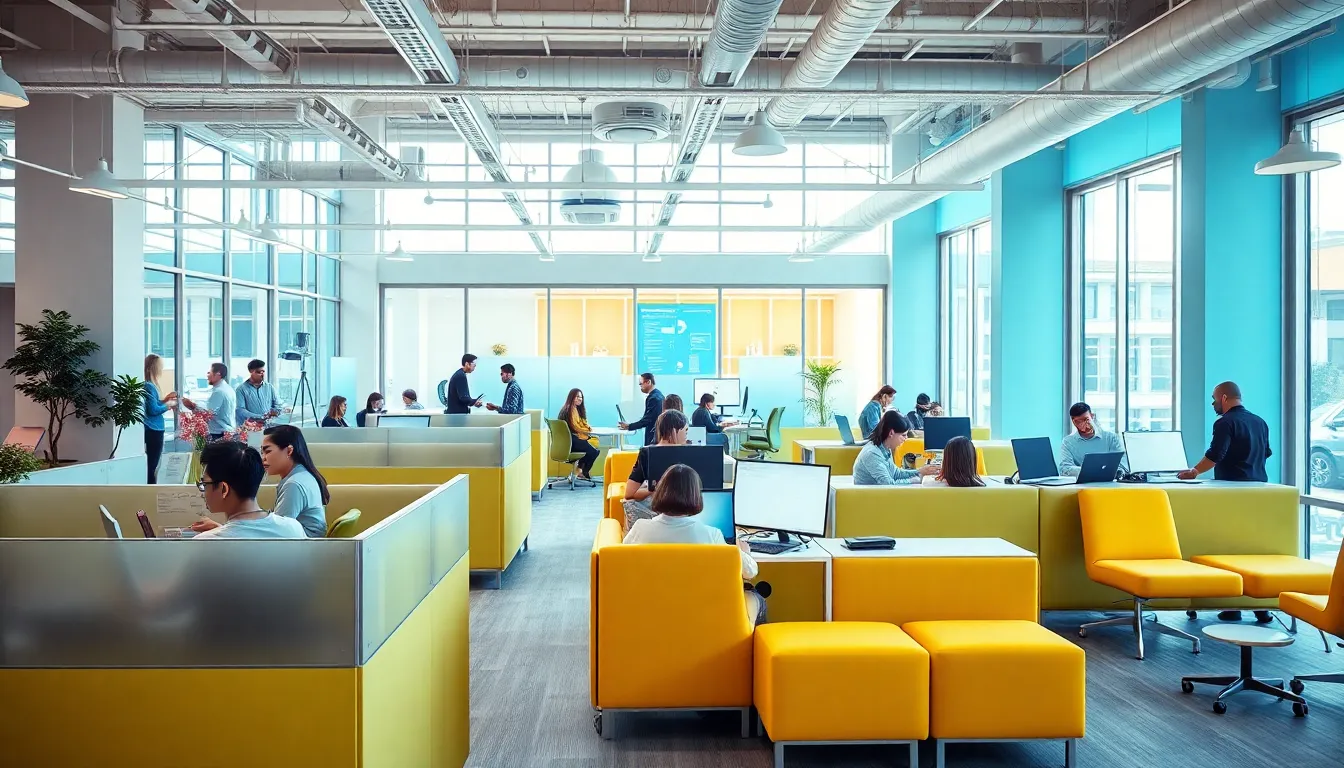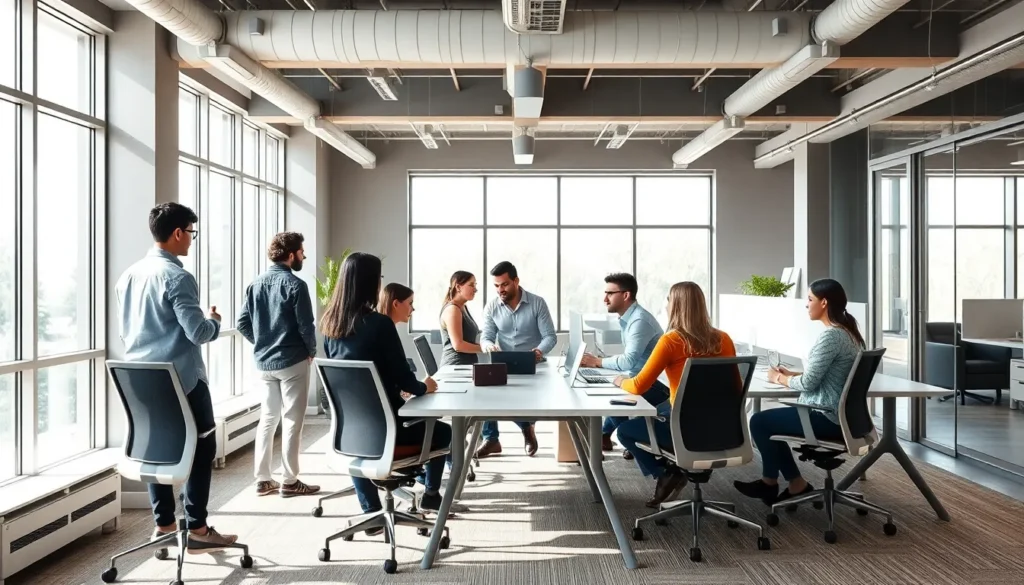Table of Contents
ToggleIn today’s fast-paced work environment, the design of an office plays a crucial role in boosting productivity. A thoughtfully designed workspace can inspire creativity, enhance collaboration, and improve overall employee well-being. As companies strive to adapt to changing work dynamics, understanding the impact of office design becomes essential.
From open layouts that encourage teamwork to quiet zones that promote focus, the right elements can transform a mundane office into a thriving hub of innovation. By prioritizing ergonomic furniture, natural light, and flexible spaces, organizations can create an environment where employees feel motivated and engaged. This article explores key strategies for designing offices that not only look great but also drive productivity to new heights.
Importance of Office Design for Productivity
Office design significantly influences employee productivity. A well-structured workspace enhances focus, creativity, and overall job satisfaction. Key elements include:
- Open Layouts: Open spaces encourage communication and collaboration. They allow teams to work together seamlessly and share ideas effectively.
- Quiet Zones: Designated quiet areas support focus and concentration. Employees can retreat to these zones for tasks requiring deep thought.
- Ergonomic Furniture: Adjustable desks and comfortable chairs promote physical well-being. Ergonomic choices reduce strain and fatigue, leading to longer work periods without discomfort.
- Natural Light: Access to natural light increases energy and morale. Studies indicate that employees in well-lit environments experience fewer headaches and eye strain.
- Flexible Spaces: Variety in workspace options fosters creativity. Employees can choose areas that suit their working style, whether they prefer collaborative, quiet, or informal settings.
Each design element contributes to a productive environment by addressing different aspects of employee needs. Thoughtful office design not only boosts output but also improves employee retention and satisfaction.
Key Elements of Effective Office Design

Effective office design incorporates several key elements that enhance productivity and employee satisfaction. These elements, including layout, lighting, and color schemes, significantly influence how employees interact with their workspace.
Layout and Space Utilization
Efficient office layouts optimize space and encourage collaboration. Open floor plans foster communication among teams, reducing barriers to interaction. Designated quiet areas promote focused work, allowing employees to concentrate without distractions. Flexible spaces, such as meeting rooms and breakout zones, accommodate various work styles, ensuring employees can choose environments that suit their tasks. Incorporating modular furniture also enhances space utilization, enabling easy reconfiguration for different projects.
Lighting and Color Schemes
Natural light enhances mood and productivity in office settings. Incorporating windows and skylights can increase exposure to sunlight, resulting in higher energy levels and improved morale. On the other hand, strategically placed artificial lighting fills gaps, creating well-lit environments conducive to concentration.
Color schemes further influence workspace atmosphere. Warm colors like yellow and orange stimulate energy and creativity, while cooler tones like blue and green promote calm and focus. Choosing colors that align with the company culture aids in establishing a cohesive brand identity and enhances employee engagement.
Creating a Flexible Work Environment
Creating a flexible work environment fosters adaptability and enhances productivity. Effective design incorporates elements that cater to diverse work styles and preferences.
Collaborative Spaces
Collaborative spaces promote teamwork and communication. These areas feature open layouts with modular furniture, enabling quick reconfiguration for different activities. Incorporating technology, such as interactive screens and high-speed internet, further supports group collaboration. These spaces should be strategically located near centralized work areas, allowing easy access for all employees, fostering spontaneous interactions and effective brainstorming.
Quiet Zones
Quiet zones provide essential settings for focused work. Designing these areas with sound-absorbing materials minimizes distractions and enhances concentration. Individual workstations can feature high-backed seating or portable partitions, allowing privacy while collaborating in nearby spaces. These zones should be easily accessible yet discreet, offering employees a retreat from the busyness of the workplace. Incorporating soft lighting and comfortable furnishings can create a calming atmosphere that supports deep work tasks.
Ergonomics and Comfort
Ergonomics and comfort play vital roles in promoting productivity within an office environment. Well-designed ergonomic furniture reduces the risk of injuries and discomfort, allowing employees to focus on their tasks. Key furniture elements include adjustable chairs, desks, and monitor stands that accommodate various body types and work preferences.
Ergonomic Furniture Solutions
- Chairs: Ergonomic chairs support the lower back, encourage proper posture, and allow adjustments for height and lumbar support.
- Desks: Sit-stand desks provide flexibility, enabling employees to alternate between sitting and standing, reducing fatigue and enhancing energy levels.
- Monitor Stands: Adjustable monitor stands help position screens at eye level, minimizing neck strain and promoting comfortable viewing.
Workplace Comfort Features
- Temperature Control: Thermostats or individual heating and cooling units ensure a comfortable climate, vital for maintaining focus.
- Acoustic Solutions: Sound-absorbing panels contribute to noise reduction, creating a quieter environment that enhances concentration.
- Lighting Options: Proper lighting, including adjustable desk lamps, prevents eye strain and supports visual comfort.
Space Organization for Comfort
- Workspace Layout: Organized workspaces reduce clutter, allowing for easier navigation and accessibility, which adds to overall comfort.
- Personalization: Allowing employees to personalize their work areas encourages a sense of ownership and boosts comfort.
Incorporating these ergonomic and comfort-oriented solutions creates an environment conducive to productivity, ensuring employees remain engaged and efficient throughout the workday.
Technology Integration
Effective office design incorporates technology to enhance productivity. Integrating advanced tools improves collaboration, communication, and workflow efficiency.
Collaboration Tools
Collaboration tools streamline team interactions. Video conferencing systems offer seamless virtual meetings, while project management software allows for real-time updates on tasks. Interactive whiteboards enable brainstorming sessions that engage employees actively.
Wireless Connectivity
Wireless connectivity fosters flexibility. High-speed Wi-Fi and strong cellular signals support mobile devices, allowing employees to work from various locations without disruption. This flexibility can lead to increased job satisfaction and productivity.
Smart Technology
Smart technology optimizes workplace environments. Automated lighting adjusts intensity based on natural light levels, reducing energy consumption and enhancing comfort. Smart thermostats maintain ideal temperatures, contributing to employee focus and well-being.
Data Analytics
Data analytics tools provide insights into workspace usage. Monitoring how spaces are utilized helps identify areas for improvement. Understanding employee preferences allows for informed decisions about design modifications.
Security Systems
Security systems protect assets and information. Implementation of access control and surveillance technology ensures a safe environment for employees and clients. This security promotes peace of mind, allowing individuals to concentrate on their work.
Incorporating these technological elements into office design significantly enhances productivity while addressing employee needs. Thereby, choosing the right solutions can create a workplace that actively supports efficient workflows and collaboration.
A thoughtfully designed office can significantly impact productivity and employee satisfaction. By prioritizing elements like open layouts, quiet zones, and ergonomic furniture, organizations can create an environment that caters to diverse work styles. Integrating natural light and strategic color schemes further enhances the workspace atmosphere, fostering creativity and focus.
Embracing flexibility in design not only accommodates various tasks but also encourages collaboration and adaptability. As technology continues to evolve, incorporating smart solutions will streamline processes and optimize comfort. Ultimately, investing in office design is investing in the workforce, leading to improved performance and a thriving workplace culture.







